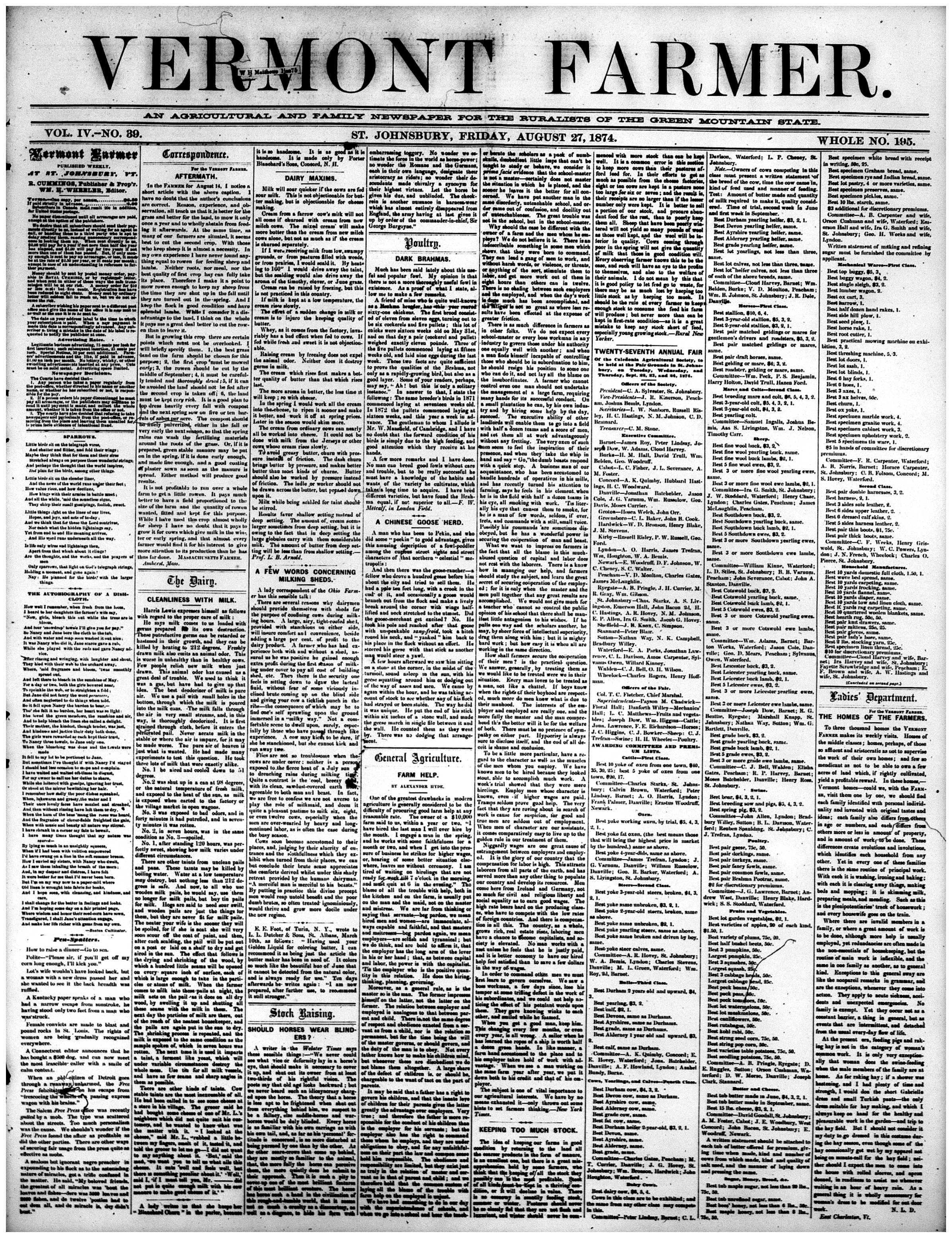Our first title selected for digitization under our NDNP grant doubles as our sample reel. We sent this reel to our potential project partner vendors as part of the RFP process. It is referred to as a “sample reel” because each of the potential vendors will create a batch of images from the microfilm as part of the evaluation for the RFP. Because it will be used for this dual purpose, the title we chose had to fulfill certain important criteria: it would preferably be a short run that fits all on one reel, the location of the master negative had to be known, and–most importantly–the title has to be historically important and interesting.
After some deliberation and searching, we found a title that meets all of these requirements:

The Vermont Farmer (St. Johnsbury, VT).
The Vermont Farmer is noteworthy in several ways. Prudence Doherty, University of Vermont Special Collections Librarian and VTDNP Project Management Team member, researched the background of The Vermont Farmer. Prudence located this wonderful article detailing the background of the title and its remarkable editor:
“Dr. Thomas H. Hoskins was born in Gardiner, Maine, on May 14, 1828, son of Henry Box Hoskins, a paper manufacturer there for forty years and twice Mayor. Following a very interesting career as a physician and surgeon in and around Boston, Massachusetts, after graduating from Louisville, Kentucky, Medical School in 1866, Dr. Hoskins received a severe spinal injury from a fall on the ice, which incapacitated him for his professional work. Soon after, at the invitation of his friends Henry Keyes and Carlos Pierce, he came to Newport to regain his health. While here, the idea occurred to him that the lake region would be a good place for fruit raising. While practicing at the Boston Dispensary he had also worked as an editorial writer on the Boston Courier. He was the author of “A Treatise on the Adulteration of Food.” Dr. Hoskins became the Agricultural Editor of the Newport Express and an expert on agriculture and horticulture.
Dr. Hoskins established a nursery at West Derby about 1868 in the Hoskins Avenue area and began experimenting with many varieties. He bought a farm in Newport Center where he developed a twelve-acre orchard and in 1890 bought 135 acres in Derby to develop one of the best orchards in New England with nearly one hundred varieties of apple trees. He attempted constantly to find the best apples to withstand the cold climate and apple trees and fruit from his nursery were readily sold. He introduced the Yellow Transparent, Scott’s Winter, Tetoffsky, the Dutchess, the Wealthy, and Newport apples. He propagated the Vermont Wonder Pea and Snowflake Potato.
In 1870 Dr. Hoskins started printing the Vermont Farmer at Newport and after two years moved it to St. Johnsbury where for four years he served as Editor with Royal Cummings as Publisher. The newspaper reached a circulation of four thousand. For two years the doctor was a member of the State board of Agriculture and contributed to the Vermont Horticultural Society records now at the University of Vermont. For twenty years he was Agricultural Editor of the Watchman and a contributor to the Rurual New Yorker, Garden and Forest, American Gardening, and other journals. His work in the nursery required money, patience, and experience over many years but he is now best remembered for the McIntosh Red apple. In 1868 Dr. Hoskins bought from the John McIntosh family nursery in Dundela, Ontario, a McIntosh apple tree which he planted in his orchard in Newport Center. This was the first McIntosh sapling planted in the United States. It is !
still living and bearing fine fruit on the Gilbert C. Whipple farm where he planted it. His work in horticulture has been continued by the University of Vermont Extension Service which has recently developed a new and improved strain of apples, called The Imperial.
Dr. Hoskins, at the age of eighteen, married Mary Jane Harrington of Boston, and after her death married Caroline A. Strong, also of Boston, who died a year later in childbirth. His third wife, Malona A. Pino of Georgia, Vermont, became the mother of his six children. In 1896 only one was still living, Mabel C., the wife of the Reverend J.B. Spires who resigned his pastorate to assist Dr. Hoskins in his fruit farming and nursery.
The Reverend Spires was born in 1862 at Reems Station, Dinwiddie County, Virginia, where his father was a Methodist clergyman and practicing physician. He graduated from Boston Theological Seminary in June, 1890, and soon married Mabel Hoskins. The Reverend Spires and Dr. Hoskins made a specialty of rhubarb, asparagus, and fruits, but their main business, beside selling many trees, was the sale of apples and small fruits. Their business increased steadily and they maintained their excellent reputation as orchardists. Dr. Hoskins possessed a vigorous and original personality.”
[Citation forthcoming, p. 155-156, from a Vermont state history book]
Besides the notable change of career from surgeon to horticulturalist after his spinal injury, it is fascinating that Dr. Hoskins introduced the McIntosh Red apple to the United States! The Vermont Farmer should provide researchers with an informative window into agricultural thought and practice in Northeast Vermont in the 1870s.
Some notes on the article: Newport and Derby are located within five miles of the Quebec, Canada border in Northeastern Vermont. The “lake region” referred to in the article is the area around Lake Memphremagog, which straddles the U.S.-Canada border. St. Johnsbury–where the publication of the Vermont Farmer moved in 1872–is about 40 miles southeast of Newport near the New Hampshire border.
– Tom McMurdo, VTDNP Project Librarian
 From the National Endowment for the Humanities:
From the National Endowment for the Humanities:
